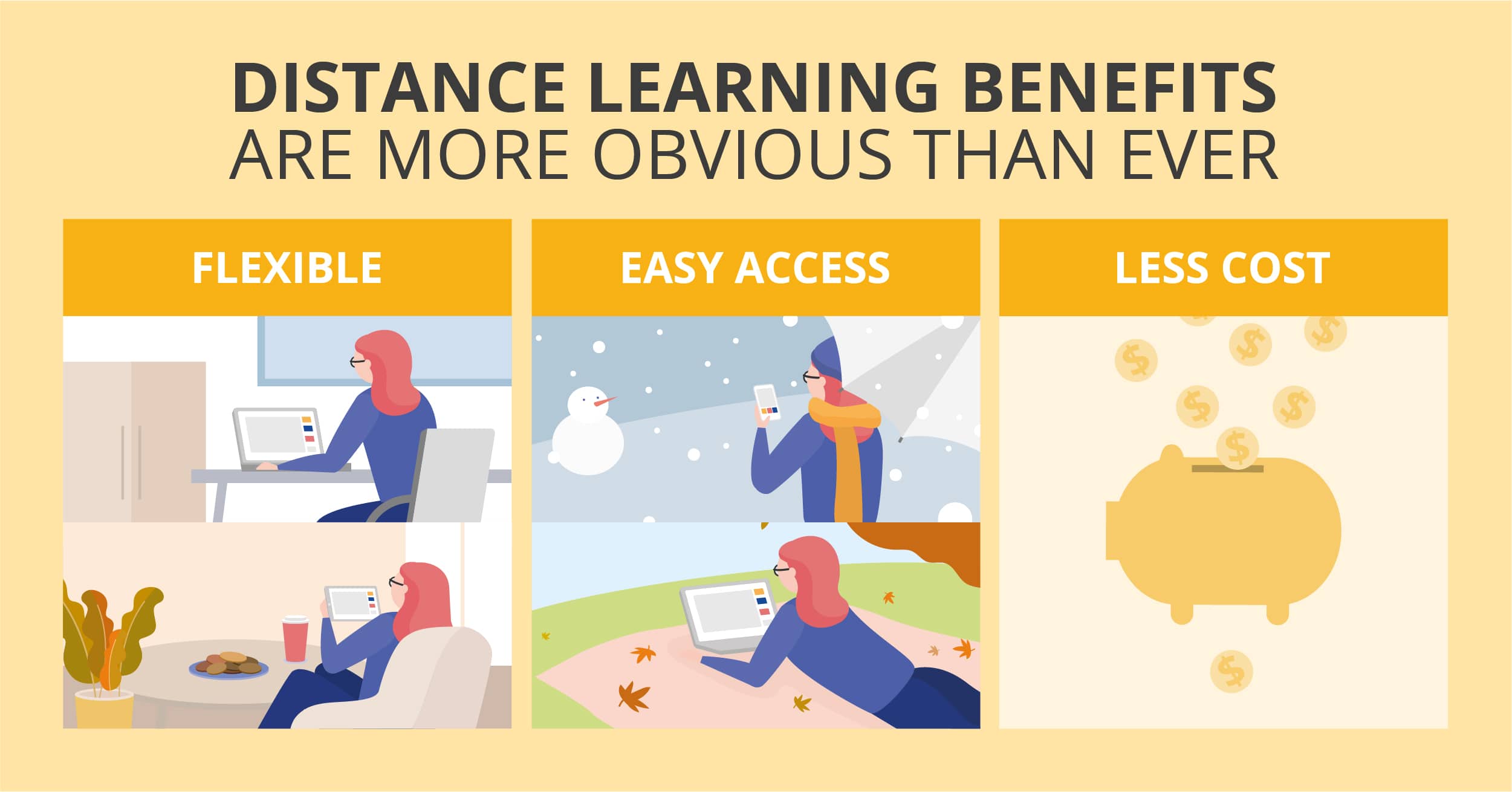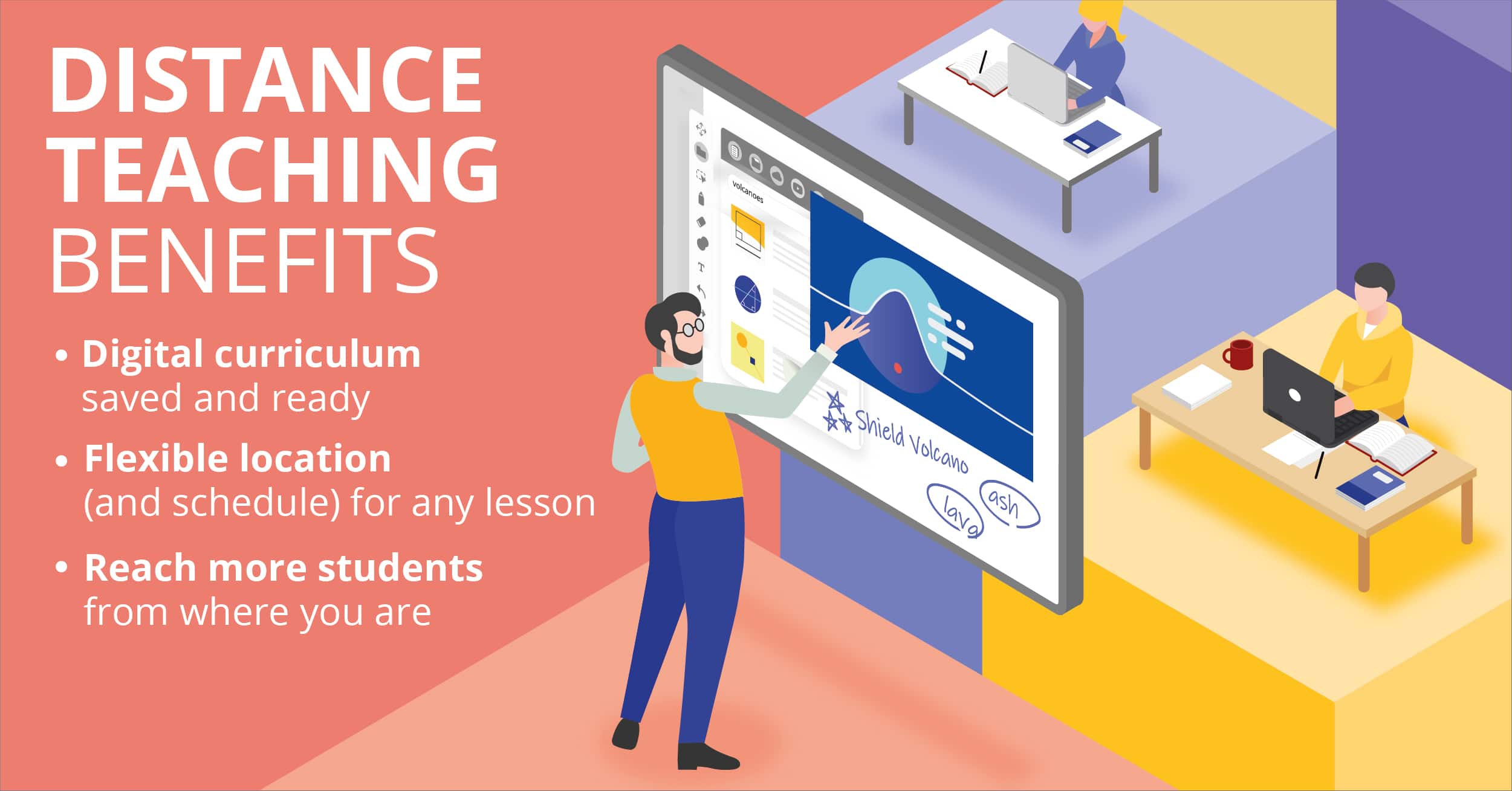Distance learning – any form of remote education where the student is not physically present for the lesson – is booming thanks to the power of the Internet. With a variety of course types to choose from, there is a rise in flexible and affordable education options. In fact, there are a number of advantages of learning remotely over even traditional teaching models.
So keep reading to learn more about distance learning. Or go straight to our recommended distance learning tool: myViewBoard Classroom.
As the Internet blurs the line between near and far, distance learning is set to disrupt the current paradigm of education. With everything from AI-driven teaching algorithms to simple message boards, there are more options than ever to learn whatever you need to know.
While skilled educators will continue to be an integral part of every student’s life, technology will bridge the physical spaces between teachers and learners. Distance learning is already part of many institutions’ programs, and it is set to become an even larger part of the education sector. But first…
What Is Distance Learning?
Distance learning describes any learning that happens without the students being physically present in the lesson. (However, this could also apply to the teacher in certain situations.)
Historically, this described correspondence courses in which students would communicate with their schools or teachers by mail. More recently, distance education has moved online to include a huge range of systems and methods on practically any connected device.
Want to learn more about distance learning? Defining Distance Learning
 Common Types of Distance Learning
Common Types of Distance Learning
Though there are lots of learning (and teaching) options online, there are a few types that are well supported by existing systems and established pedagogies.
- Video conferencing is a common way for teachers to interact directly with students in live lessons. This could be a one-on-one session or a class-like scenario in which multiple students connect to the teacher live.
- Synchronous learning is when all the students learn together at the same time (and often even place) but the instructor is at another location. It often features video or teleconferencing that connects teachers and learners digitally.
- Asynchronous learning is a less connected but also less constrained format. Instead of live online lessons, students are given learning tasks with deadlines. They then self-study to complete the assignments.
- Open-schedule online courses add yet another layer of flexibility. It is a type of asynchronous course setup, except there aren’t any deadlines either. This is ideal for learners with other demands on their time, such as professionals or stay-at-home parents.
- Fixed-time online courses are a type of synchronous course that requires online users to all visit a specific virtual location at a set time and place (e.g. a webinar). Unlike more rigid synchronous lessons, this does allow students from anywhere in the world to connect and interact online.
- Computer-based distance education is a fixed-time, synchronous lesson on computers, usually a computer lab. This is most common in existing institutions that already have access to the necessary devices.
- Hybrid learning is a specific type of blended learning where students are learning the same lesson in real-time (i.e. synchronous distance learning) but some of the students are physically present while others are learning remotely.

Are you more interested in live education? Technology in the Classroom: The Complete Guide
How Is Distance Learning Different from Regular Learning?
Distance education is clearly different from regular education in terms of a student or teacher’s physical presence. But what does that mean, exactly?
For the most part, it translates into increased freedom for both learners and educators, but it also requires higher degrees of discipline and planning to successfully complete the course of study.
The enhanced freedom of remote learning is most clearly seen in the fact that students can choose courses that fit their schedules and resources. (Teachers can do the same.) And in the case of digital learning, students can also choose the location and teaching styles that best suit their needs.
The flip side of freedom, however, is the discipline required to make the most of the lessons. Students need to self-motivate in order to actually get the work done, especially in systems that don’t require them to be present in some specific time or place. Teachers also need to be better organized with contingencies should their students need additional explanation, again especially if they are not teaching live and able to “read the room.”
In certain cases, however, distance learning is not just required but the best possible option. There are times when the advantages of remote education really have a chance to shine.
Advantages of Distance Learning
Certainly, live instruction is great. The face-to-face contact lets teachers and students connect in a very authentic way, which often results in strong rapport and understanding. While not impossible, this kind of connection still seems much easier in person. So why is distance learning even a thing?
As it turns out, there are a number of advantages when learning remotely. Here are just a few.
Flexibility
The top benefit of distance education is its flexibility. Students can choose when, where, and how they learn by selecting the time, place, and medium for their education. For those who want direct, live access to teachers there are video conferencing options. But for students who may be doing their training around a job or other responsibilities, a more relaxed schedule may work better. There are options to match virtually anyone’s needs.
And thanks to the proliferation of online learning options, there is a course structure on practically any subject that a person would want to study.
Easy Access
Whether due to remote location or being differently-abled, some students lack basic access to educational facilities. Remote learning programs offer every student the opportunity to learn and improve themself in the environment they find the most effective.
Want to make a live classroom more accessible? 6 Cases of Interactive Digital Whiteboards as an Assistive Technology in Special Education
Remote learning also opens up new horizons of education in terms of international institutions. Major universities and trade schools the world over now offer recognized degrees, certificates, and professional qualifications online to learners of all ages. Or motivated people can get more basic certificates of completion everywhere from Udemy to Google Skillshop.
Less Cost
Thanks to the scalable nature of digital learning especially, distance learning is driving down the cost of education. Online degrees are becoming almost commonplace, and there are even accredited online-only universities that can eliminate expensive infrastructure overhead and get straight to the teaching.
And those schools that offer both can offer the same program for drastically different prices. For example, an in-state undergraduate student for Purdue University (ranked #57 in the United States) estimates in-person tuition and living expenses at $22,782 a year, usually requiring four years of study. International students’ tuition skyrockets to $45,594 per year. The same degree online would cost $50,085 in total.
What to Look for in a Distance Learning System
Regardless of whether you are an educator or a student, there are certain features that you should look for in a distance learning system to get the most out of it.
Ease of Use
Simplicity is the key. Any system you adopt to either teach or learn should be user-friendly for everyone involved. This means a clear interface and a set of certain essential features that include:
- Digital whiteboarding and annotation
- Media creation and sharing
- Screen recording with audio
- Direct student-to-teacher communication
- Multi-device compatibility
Accreditation
The credibility of a remote learning platform is really a combination of the instructor and the platform itself. For learners, it’s important to note how well recognized that platform’s credentials are. Does it provide a recognized degree? A professional certificate? A certificate of completion? These are all things to keep in mind before enrolling.
And educators looking to adopt a remote learning system, it’s important to know what kind of accreditation that system can bestow on your behalf or on the behalf of your institution. For academic degrees or professional qualifications, recognition by outside regulatory bodies will likely be necessary.
Schedule
As most distance learning systems are made to be fairly flexible in this regard, the course schedule has a lot to do with its content and not the system. Still, it’s an important factor to consider when choosing a course.
Is it a synchronous or asynchronous course? Are there deadlines or not? How long do you have to complete the entire course? And does the course’s schedule match yours?
Want to see an example of an online tool that checks all the distance learning boxes? Check out myViewBoard.
Wrapping Up
Remote education is certainly not a magic bullet and there will always be a place for in-class learning. At the same time, distance learning still has a lot of untapped potential to reach students where they are and connect educators and learners in new ways. From increased flexibility to new learning styles, it seems that the future of learning will be as diverse in time and place as it will be in thought.
To learn more about what myViewBoard Suite can do for you in your teaching or learning click here. Or find out more about ViewSonic’s comprehensive EdTech solutions. 